Reviews
Dennis Hopper
USA, 1971
Credits
Review by Leo Goldsmith
Posted on 10 April 2013
Source Universal Pictures 35mm print
External links
“Drugstore Cowboy”: J. Hoberman’s review in The Village Voice
“(En) fin de cinema”: Andrew Tracy’s review in Reverse Shot
Categories Acid Westerns
Vicious, fractured, bloated, and monumentally self-regarding, Dennis Hopper’s The Last Movie comes with a sense of finality already implanted in its title, a death drive embedded in its psyche, and the path to its own destruction encoded in its DNA. And while hindsight and Hollywood lore are always murky, it’s tough to imagine that the irony of the film’s title - an announcement of career-suicide riffed on in every pan the film has ever received - was lost even on the film’s apparently addled and egotistical director, writer, and star.
Certainly the film’s reputation as a hitherto unrivaled disaster of hubristic auto-auterism and ridiculous hippie flailing would seem to be confirmed by what’s onscreen. Shot in and around the town of Chinchero, Peru, on the heels of Easy Rider’s massive success, Hopper’s film seems at first glance a sketchily plotted boondoggle, rife with in-jokes, metacinematic ticks, and plaintive ballads by Kris Kristofferson (and decidedly lesser talents). Immediately plunging the spectator into the location-filming of a Hollywood B-Western (directed by Sam Fuller, no less), the film abruptly reframes itself as a portrait of a midsize Peruvian town once the studio trucks have left, as seen through the delusional eyes of a Hollywood horse-wrangler named Kansas. With Hollywood gone, the “simple villagers” begin to make their own movies with camera equipment constructed out of something like wicker and a preference for real, rather than staged, violence. In a fashion similar to Easy Rider, though far more radically, this seemingly basic set-up leaps backwards and forwards in time until the film’s final moments. Dissolving into more of a blooper reel than a Hollywood ending, the film lets the fourth wall drop with a thud to reveal Hopper and cast flailing about on-set, drinking heavily, and falling down to the bemusement of the Peruvian locals and extras on hand.
But The Last Movie is in fact a fascinating and unusually thoughtful film, an astute and rather nasty allegory of Hollywood’s cultural imperialism that seemingly could only have come from one of Tinseltown’s very own longtime residents. With Godard’s late-60s work and the macho mythopoetics of Alejandro Jodorowsky as inspirations, the film is blazingly obtuse, shifting in tone and target seemingly at random. Scenes arise out of order, often with a nebulous connection to what we have previously understood to be the plot, and still others are ironically denoted as having been excised or lost, thanks to the intrusion of helpful (and ludicrous) “Scene Missing” titlecards. Hopper’s intention is nothing less than a suicide-attack on the Hollywood movie, and his film is the very image and embodiment of that terrorist impulse. But while Hopper’s self-consciously bad trip looks like a curious end-of-an-era artifact today, it’s hard to imagine what a gut-blow it must have seemed in 1971. The saga of Dennis Hopper’s personal and professional implosion in the 1970s is by now a familiar Hollywood tale, a downward spiral of drugs and insanity, exemplified by his manic, hand-flailing turn in Coppola’s Apocalypse Now and purified in the fire of Frank Booth’s perversion in Lynch’s Blue Velvet. But it’s often difficult to conceive of a time when the actor was anything more than a crazy motherfucker, a time when he was generally considered a walking cinematic icon, an incisive chronicler of his times, a brilliant auteur, and the savior of Hollywood. Forty years on, the film that established this, Easy Rider, remains a cultural watershed, itself mythologized as the moment when Old Hollywood conceded its loss to the New. And even if the film itself is seemingly blind to its own political ironies and dated by its own stoner naïveté, it nonetheless still bears traces of a set of influences that reaches far across the 1960s cultural landscape.
As Billy, the guffawing David Crosby to Peter Fonda’s boyish Captain America, Hopper turns in a performance that seems to us now invisibly clownish. In reality, his portrayal of the iconic and ill-fated drug-running hippie biker belies the actor’s central place in the milieu of contemporary American culture, where he was not only a friend to James Dean, student of Lee Strasberg, and a fortysomething Nick Ray’s romantic rival for the affections of a 16-year-old Natalie Wood, but also an accomplished professional photographer, an activist in the Civil Rights Movement, and a longtime art collector of Pop Art by James Rosenquist and Andy Warhol. While Hopper is often more commonly identified with his connections to mainstream Hollywood, the influence of avant-garde filmmakers like Warhol (for whom Hopper did a “screen test” and appeared in Tarzan and Jane Regained… Sort of) and especially his longtime friend Bruce Conner is the source of the experimental approaches to film narrative, acting, and editing in his early films. In particular, the influence of the intense montage of Bruce Conner’s 1967 film Looking for Mushrooms can be discerned in the disjunctive editing and imagery of the LSD hallucinations he had filmed as second unit director of Roger Corman’s The Trip (which starred Peter Fonda), as well as Easy Rider’s New Orleans cemetery sequence.
In The Last Movie, Hopper draws on the influence of contemporary American (and especially West Coast) avant-garde cinema even more heavily as an explicit means of critiquing Hollywood and American culture, in general. Originally inspired by Hopper’s experiences on the Mexico set of The Sons of Katie Elder in 1965, The Last Movie was co-written with Rebel Without a Cause screenwriter Stewart Stern with the idea that it would be Hopper’s directorial debut. Easy Rider took its place, making its director an international success in the process—and Hopper responded with a sneering counter-attack. In The Last Movie, Hopper wanted to make film that, unlike its predecessor, could not be consumed and repackaged and capitalized upon. Rather than wistful nodding to the American Dream’s dying embers, the film indicts American influence and idealism as a mindless and corruptive paradox. This becomes emblematized in the exploitation of the Peruvian village a movie set for a Western—it’s Hollywood’s desire to literally convert the world into America’s image, a refractive play of iconic surfaces (as in a Rosenquist painting). Once it’s outlived its usefulness, it’s quickly discarded. Of course, the redemptive force of 1960s counterculture fairs no better in Hopper’s vision. Following on the famous downer denouement of its predecessor, The Last Movie is marked by the exhaustion with the hippie hypocrisy of 1960s idealism. Sexual liberation is the excuse for sexual exploitation, and free love soon finds its price tag. Dropping out and going native are mirages of a romantic, delusional sensibility, complete with Marlboro Man iconography and plaintive flower-child ballads.
Of course, these charges against American imperialism and the Hollywood machine are hardly novel, and Hopper’s film is not exactly commendable for its keen argumentation or shrewd insights into the human condition. In fact, quite the opposite: the film’s contorted perspective and disjunctive tendencies continually suggest the film’s own complicity in precisely those insidious and corruptive forces of Americanness it means to expose: racism, misogyny, greed, arrogance, and deception. After all, The Last Movie is itself the product of a major Hollywood studio that colonizes a small corner of the Third World for its own ends. Lost in some kind of delusional American Dream of his own, Hopper pompously offers himself up as the sacrificial lamb, as Kansas unwittingly takes the lead role in the indigenous population’s “last movie,” a quasi-revolutionary conversion of cinema into death ritual.
But The Last Movie is a movie of violent contradictions, and ultimately it is this violence, this self-hatred, that tears the film from its narrative. The extra-diegetic conclusion exposes the film for what it is, turning all of its own questions back on itself, executing a pirouette that’s witty, self-lacerating, embarrassing, and beautiful all at once. Dropping the façade entirely, Hopper visibly indulges in the self-mythologizing and exploitive chaos of moviemaking: he drinks, yells, and runs madly through a village square as the locals look on in confusion at the silly American. It’s disquieting to watch both Hopper and his film self-destruct on the movie screen, but perhaps this sort of death strikes just the right note of finality.
More Acid Westerns
-
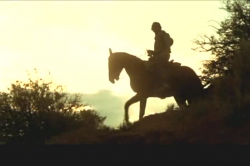
Ride in the Whirlwind
1965 -
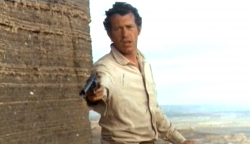
The Shooting
1966 -
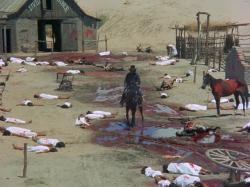
El Topo
1970 -
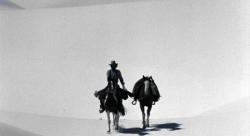
The Hired Hand
1971 -
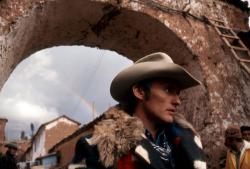
The Last Movie
1971 -
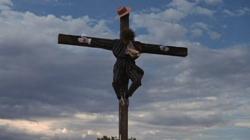
Greaser’s Palace
1972 -
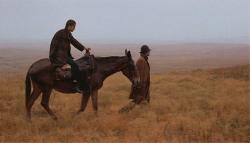
Bad Company
1972 -
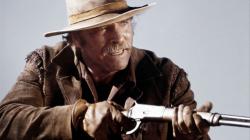
Ulzana’s Raid
1972 -
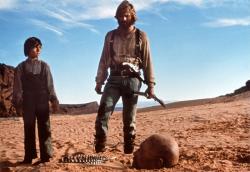
Jeremiah Johnson
1972 -
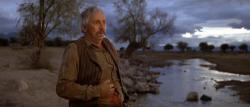
Pat Garrett & Billy the Kid
1973 -

Kid Blue
1973 -

Dead Man
1995
We don’t do comments anymore, but you may contact us here or find us on Twitter or Facebook.



